< Puzzles
Shade grid puzzles are named as such due to in order to solve the puzzle shading the grids is a must. Below are types of shading puzzles
Kuromasu
Rules
- Certain cells are shaded so that each number indicates total number of cells that are "visible"/ unshaded cells in the same row and column, including cells itself
- No cells with number can be shaded
- Shaded cells cannot touch except diagonally
- All unshaded cells must form a single continuous area, you can travel horizontal and vertically from cells to cells
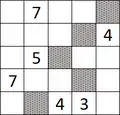 Examples of solved Kuromasu
Examples of solved Kuromasu
Clouds
Rules
- Shade rectangular group of cells so that each group is at least 2 cells wide and at least 2 cells tall ( > 2X2)
- Each shaded rectangular cannot touch at all even diagonally
- The number given is the number of shaded cells in each rows and columns
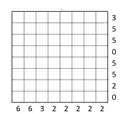 Cloud puzzles
Cloud puzzles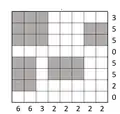 Cloud solved puzzles
Cloud solved puzzles
Light Up
Rules
- Place light bulbs in some empty cells so that each empty cells is illuminated
- Light bulbs illuminate every cell in their row and column until being blocked by black cell
- No light bulb can be illuminated by other light bulb
- Some black cells have number, corresponding to the number of touching, non diagonally cells
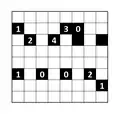 Example of empty puzzles
Example of empty puzzles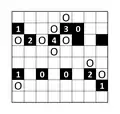 Example of solved puzzles
Example of solved puzzles
Mosaic
Rules
- Shade some grid cells, which may include the numbers printed on them
- A number in cell reveal the number of shaded touching cells, including touching diagonally and the cell itself
- The finished puzzle will reveal a simple picture
Gallery
Heyawake
Rules
- Shade some grid cells, so that no 2 shaded cells are adjacent (except diagonally) and unshaded cells forming single continuous area
- Any single horizontal or vertical group of unshaded cells cannot cross more than one bold line region
- Number cells may or may not be shaded but it always gives the precise amount of shaded cells inside the bold line region
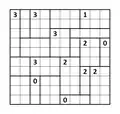 Empty heyawake puzzles
Empty heyawake puzzles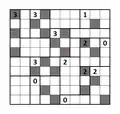 Example of solved puzzles
Example of solved puzzles
Tapa
Rules
- Shade some cells to form contiguous shaded region
- Numbers in a cell reveal length of each group of touching shaded cells (Including diagonally touching cells)
- If there are more than one number in a cell, meaning there must be at least one unshaded cell
- Shaded cell cannot form 2X2 square or larger
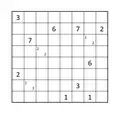 Example of Tapa puzzles
Example of Tapa puzzles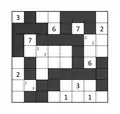 Examples of Tapa solved puzzles
Examples of Tapa solved puzzles
Minesweeper
Rules
- Place mines into empty cells in the grid
- Number in the cells meant that humber of mines touching the cells itself (including diagonally)
- Only one mine may be placed per cell
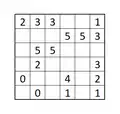 Example of Minesweeper puzzles
Example of Minesweeper puzzles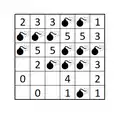 Example of solved Minesweeper puzzle
Example of solved Minesweeper puzzle
Snake
Rules
- Shade some cells to form a single snake that starts and ends at the given cells
- The "snake does not cross over itself
- The snake does not touch itself (even diagonally, except when turning cornet)
- Number outside the grid specify number of cells in row/column contain part of the snakes
 Example of snake puzzle
Example of snake puzzle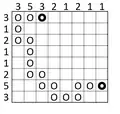 Example of solved snake puzzle
Example of solved snake puzzle
Hitori
Rules
- Shade some cells so that no numbers repeat in any row of column
- Shaded cells cannot touch except diagonally
- All shaded cells must form a single unconnected region
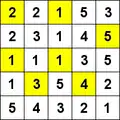 Example of Hitori solved puzzles
Example of Hitori solved puzzles
Mochikoro
Rules
- Shade some cells so that every numbers in the puzzle remain as part of continuous unshaded rectangle of precisely the given cells
- Shaded cells cannot form areas larger than 2X2
- Not all unshaded rectangles are necessarily marked with numbers
- In this puzzle, rectangle can meant square too.
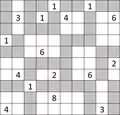 Example of solved puzzles
Example of solved puzzles
Star Battle
Rules
- Place stars in some cells so that each row , column and outlined region contains exactly two stars
- Stars cannot touch each other, not even diagonally
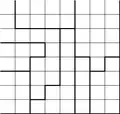 Example of Star Battle puzzles
Example of Star Battle puzzles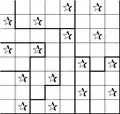 Example of solved Star Battle puzzle
Example of solved Star Battle puzzle
This article is issued from Wikibooks. The text is licensed under Creative Commons - Attribution - Sharealike. Additional terms may apply for the media files.